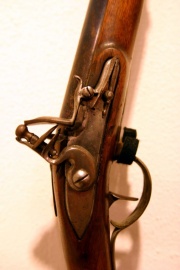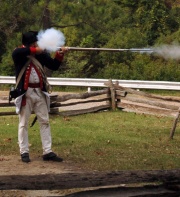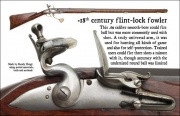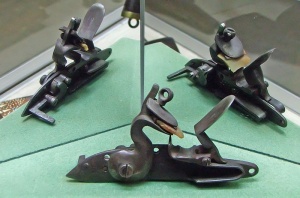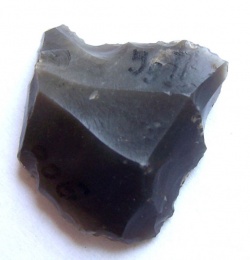Difference between revisions of "Flintlock"
(New page: ignition sequence [[Image:Musee-historique-lausanne-img 0086.jpg|thumb|Flintlock of an 18th Century hunting rifle, with piece of flint missing....) |
m (1 revision) |
Latest revision as of 16:26, 15 March 2013
Flintlock is the general term for any firearm based on the flintlock mechanism. Introduced about 1630, the flintlock rapidly replaced earlier firearm-ignition technologies, such as the matchlock and wheellock mechanisms. It continued to be in common use for over two centuries, replaced by percussion cap and, later, cartridge-based systems in the early-to-mid 19th century. The Model 1840 U.S. musket was the last flintlock firearm produced for the U.S. military although there is evidence obsolete flintlocks were seeing action in the earliest days of the American Civil War. In fact, during the first year of the war, the Army of Tennessee (Confederacy) had over 2,000 flintlock muskets in service. While technologically obsolete, flintlock firearms have enjoyed a renaissance among black powder shooting enthusiasts and many fine flintlock rifles and pistols are being made today.
Contents |
[edit] Subtypes
Flintlocks may be any type of small arm: long gun or pistol, smoothbore or rifle, muzzleloader or breechloader. Because of the time needed to reload (the fastest experts could reload a smooth-bore muzzle-loading musket in about fifteen seconds), these weapons were sometimes produced with two, three, four or more barrels; however, multiple-barreled weapons were never very popular. The designs tended to be expensive to make and failure-prone. It was frequently cost-effective and more reliable to simply carry multiple single-shot weapons instead. Multi-barreled (up to eight) pistols had the barrels spread out in a 180 degree fan. All barrels fired at the same time, with a single lock. Known as a "Duck Foot" because of the resemblance in shape, they were intended primarily to be used by a ship's captain as a last ditch effort to defend against mutiny.
Flintlock muskets were the mainstay of European armies between 1660 and 1840. A musket was a muzzle-loading smoothbore long gun that was loaded with a round lead ball, but it could also be loaded with shot for hunting. For military purposes, the weapon was loaded with ball, or a mixture of ball with several large shot, and had an effective range between 40 and 100 meters. Smoothbore weapons that were designed for hunting birds were called "fowlers". They tended to be of large caliber. They usually had no choke, so they could also be used to fire a ball.
Some flintlock hunting arms had rifled barrels. Rifling is the process of cutting spiral grooves into the inside of the barrel. A tight-fitting projectile will tend to spin, which stabilizes its flight by the gyroscopic principle. Rifles are more accurate and have longer effective ranges than muskets but they take more time to load than a smooth-bore musket. The first rifled arms were introduced about 1500]. Versions made in Germany for hunting large game such as boar had barrels about 50-75 centimeters long. When German immigrants settled in America, particularly in Pennsylvania, they adapted their technology to the type of game available and the demands of the Indian trade, and built the long rifle, an improvement on the small game rifles used in Europe. This weapon has a barrel 90 to 115 centimeters long, and carefully loaded and shot, will be accurate up to 300 meters.
Flintlock pistols were used as self-defense weapons and for duelling, and as a cavalry arm. Their effective range was very short, and they were frequently used as an adjunct to the sword or cutlass. Pistols were usually smoothbore although rifled pistols were produced.
[edit] History
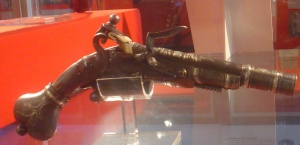
French courtier Marin le Bourgeoys made the first firearm incorporating a true flintlock mechanism for King Louis XIII shortly after his accession to the throne in 1610. The development of firearm lock mechanisms had proceeded from matchlock to wheellock to snaplock to snaphance and miquelet in the previous two centuries, and each type had been an improvement, contributing some design features which were useful. Le Bourgeoys fitted these various features together to create the flintlock mechanism. The new system quickly became popular, and was known and used in various forms throughout Europe by 1630.
Various breech-loading flintlocks were developed starting around 1650. The most popular action has a barrel which was unscrewed from the rest of the gun. Obviously this is more practical on pistols because of the shorter barrel length. This type is known as a Queen Anne pistol because it was during her reign that it became popular (although it was actually introduced in the reign of King William III). Another type has a removable screw plug set into the side or top or bottom of the barrel. A large number of sporting rifles were made with this system, as it allowed easier loading compared with muzzle loading with a tight fitting bullet and patch. One of the more successful was the system built by Isaac de la Chaumette starting in 1704. The plug passed completely through the barrel and could be opened by 3 revolutions of the triggerguard, to which it was attached. The plug stayed attached to the barrel and the ball and powder were loaded from the top. This system was improved in the 1770's by Colonel Patrick Ferguson and 100 experimental rifles used in the American Revolutionary War. The only two flintlock breechloaders to be produced in quantity were the Hall and the Crespi. The first was invented by John Hall for the US Army in 1810. The Hall rifles and carbines were loaded using a combustible paper cartridge inserted into the upward tilting breechblock. Hall rifles leaked gas from the often poorly fitted action. The same problem affected the muskets produced by Giuseppe Crespi and adopted by the Austrian Army in 1771. Nonetheless, the Crespi System was experimented with by the British during the Napoleonic Wars, and percussion Halls guns saw service in the American Civil War.
[edit] Method of operation
- A cock or hammer tightly holding a bladed piece of flint is rotated to half-cock (Lock);
- The operator loads the gun, usually from the muzzle end, with black powder followed by shot or a round lead ball, usually wrapped in a paper or cloth patch, all rammed down with a special rod (the ramrod), that is usually stored on the underside of the barrel (and Load);
- The flash pan is primed with a small amount of very finely ground powder, and the flashpan lid or frizzen is closed;
The gun is now in a "primed and ready" state, and this is how it would typically be carried while hunting or if going into battle. A safety notch at half-cock locks the cock to prevent it from falling by pulling the trigger.
To fire:
- The cock or hammer is moved from half-cock to full-cock, releasing the safety lock on the cock;
- The gun is aimed and the trigger is pulled, releasing the cock or hammer holding the flint;
- The flint strikes the frizzen, a piece of steel on the priming pan lid, opening it and exposing the priming powder;
- The contact between flint and frizzen produces a spark that is directed into the flashpan;
- The powder ignites, and the flame passes through a small hole in the barrel (called a vent, or touchhole) that leads to the combustion chamber, igniting the main powder charge there; and the gun discharges.
The British army used paper cartridges to load their weapons. The powder charge and ball were instantly available to the soldier inside this small paper envelope. When commanded, he:
- Moved the cock to the half-cock position;
- Tore the cartridge open with his teeth;
- Poured a small amount of powder into the flashpan;
- Closed the frizzen to keep the priming charge in the pan;
- Poured the rest of the powder in the cartridge down the muzzle and stuffed the cartridge in after it;
- Took out his ramrod and rammed the ball (still in the cartridge) all the way to the breech;
- Returned his ramrod and shouldered his weapon. Now he is ready to place the weapon on full cock and fire when commanded.
[edit] Cultural impact
Unlike most weapons systems and configurations, which last a few decades, the flintlock mechanism was center stage for both military and civilian use for over 200 years. Not until the Reverend Alexander John Forsyth, a Scottish minister, invented the rudimentary percussion system in 1807 did the flintlock system begin to decline in popularity. Because there is a moments hesitation between the sound of the flint striking the frizzen and the main charge igniting, Forsythe was often frustrated when hunting waterfowl, which bolted at the first sound. Also, the humid marsh conditions he hunted in often caused a failure of the pan gunpowder to ignite. Reading scientific pamphlets informed him of chemically made crystals that made sparks when crushed. This led him to conceive the idea of a small copper cup filled with these crystals that were sealed against moisture. Flintlock rifles were easily modified to allow the cap to be placed over the existing priming hole. The slide from flintlock to percussion cap was a slow one, even at that, since the percussion system was not widely used until around 1830. The flintlock continued in common use until the time of the American Civil War.
As a result of the flintlock's long active life, it has left lasting marks on the language and on drill and parade. Terms such as: "lock, stock and barrel," "going off half-cocked" and "flash in the pan" remain current in the English language. In addition, the weapon positions and drill commands that were originally devised to standardize carrying, loading and firing a flintlock weapon remain the standard for drill and display (see manual of arms).

